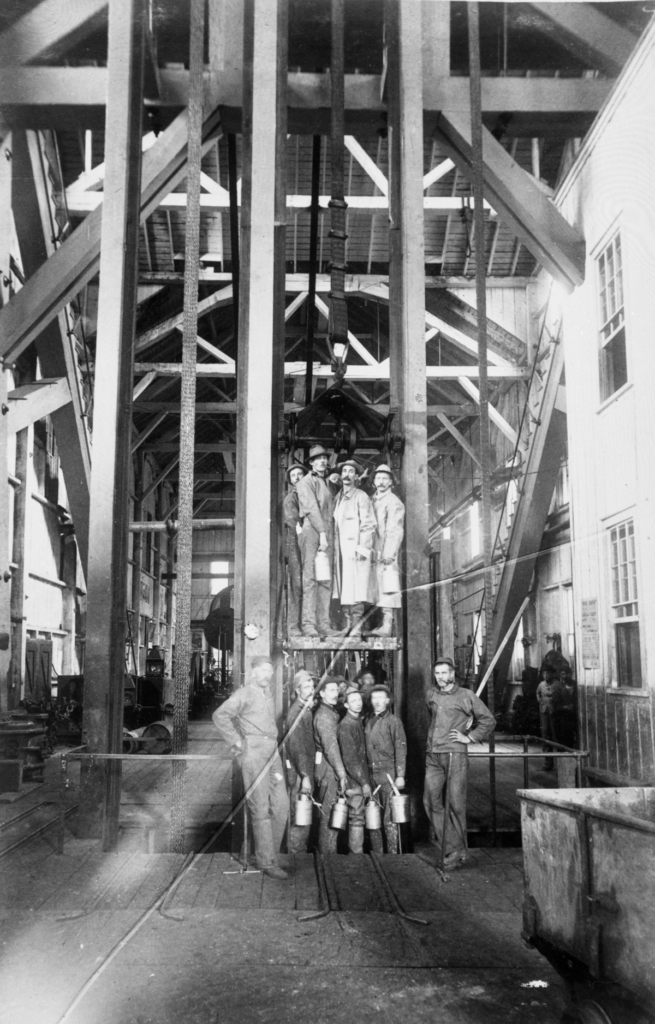In Salt Lake City there are more than ten buildings over 300 feet high and two extending up over 400 feet. Denver has 45 structures over 300 feet tall, eight over 500 feet, five over 600 feet – and the highest is just over 700 feet tall. The tallest buildings in the U.S. are in Atlanta (1,040′), San Francisco (1,070′), Los Angeles (1,018′), Chicago (1,450′), and New York City (1,776′).
Have you ever thought about the invention that makes it possible for people to occupy such lofty heights? As you move up and down in an elevator you really have no comprehension of the vertical shaft that you are whisking along. But imagine if you could see everything: the guide rails that the elevator compartment rides along to keep it securely located within the elevator shaft, the steel cables or “ropes” attached to the hoist drum at the top of the elevator shaft, and even the shaft itself beneath you.
So what does this have to do with the way we were in Park City? Well, John Mason Boutwell’s 1912 Professional Paper 77, “Geology and Ore Deposits of the Park City District” makes the statement that in the hills around Park City there were over 20 mine shafts that were deeper than 500 feet and three over 1,500 feet deep.
Each of these mine shafts was built similarly to the elevator shafts in our skyscrapers. Each had a hoist and hoist ropes connected to elevator compartments, called “cages”, that slid up and down the shafts along vertical guides. The levels down the shaft were often spaced every 100 feet or more and each of the tunnels at these levels accessed the shaft at places called “stations”. At the shaft stations there were no solid doors blocking access to the shaft until the cage arrived, unlike today’s building elevators. In old photographs it appears many shaft stations were only equipped with a single safety bar at waist height that you would raise to access the cage. That safety bar was all there was to keep you from stepping out into the open shaft!
Miners were transported up and down the shafts in the cages, but opposed to modern elevators, the cages were simple platforms with no solid walls. You wonder how the guys at the edges of the platform felt as the cage moved quickly while the sides of the shaft zoomed by… keep your arms in and no pushing in back!

Credit: Park City Historical Society & Museum
Our Park City mine shafts are cousins to the elevator shafts in modern skyscrapers, and directly comparable regarding length. They are all vertical structures made to transport people and materials to various levels along their lengths. It’s all in how you measure the length – from the bottom up (building height) or top down (shaft depth).
Now imagine all of Park City’s mine shafts were upended and extended up into the air instead of deep underground. The Salt Lake City skyline would have nothing to compare with the tall shafts of Park City! In fact, there is not another city in the country that has skyscrapers that could top the height of Park City’s shafts.
In Ontario Canyon alone there would be six shafts that would reach over 500 feet high, three of them would be over 1,000 feet, and the Ontario No. 3 would be 2,400 feet high! In Empire Canyon there would be eight shafts more than 600 feet high, five over 1,000 feet, and the Daly-West would be 2,100 feet high! Over by Treasure Hill the Silver King shaft would be 1,325 feet high and the Thaynes shaft would reach up to almost 1,800 feet. Park City would have several shafts higher than the tallest skyscraper in the country: the 1,776-foot One World Trade Center in New York City.
The Park City shafts transported millions of miners over more than 100 years, and over much longer distances than the elevators in the country’s skyscrapers. And unlike their skyscraper cousins, the Park City shafts also lifted millions of tons of rock. So hats off to those amazing miners in Park City’s past that built and operated so many “skyscrapers in the hills”.
Join us for the next virtual Park City Museum lecture that Clark Martinez and I will present on May 5 from 5 p.m. to 6 p.m.: “When the Daly West Shaft Collapsed”. Register here.
Brian Buck is a geologist, resident of Park City, member of the Park City Museum and Friends of Ski Mountain Mining History, and has more than 44 years of experience working with the mining industry.